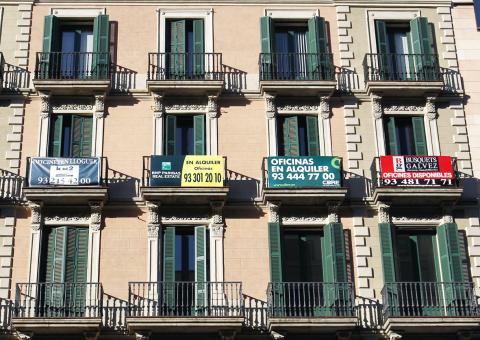Spain announced on Friday drastic reforms forcing banks to set up a new 30 billion euro (US$39 billion) financial cushion and to remove risky property assets from their accounts.
Spanish Prime Minister Mariano Rajoy’s government took the sweeping action just two days after it nationalized the fourth-biggest bank, Bankia, to salvage a balance sheet dripping in red ink.
Madrid will charge two independent auditing firms with valuing banks’ exposure to the collapsed property sector, still reeling from a housing bubble that popped in 2008, ministers told a news conference.

Photo: Reuters
“The government wants complete transparency, clarity is crucial to end any doubt about Spain’s solvency,” Spanish Economy Minister Luis de Guindos told the conference after a Cabinet meeting.
At the same time, the minister stressed that the reforms will not be funded with taxpayers’ money, thus preserving Madrid’s efforts to rein in mushrooming state debt.
Bankia, in which the state is taking a 45 percent stake as a crisis measure, had 37.5 billion euros in exposure to the property sector at the end of last year.
Of that total, loans worth 31.8 billion euros were classed as problematic.
The hangover from the property sector crash extends across the financial sector.
Bank of Spain figures show the commercial banks held problematic real-estate assets, including loans and seized property of 184 billion euros, 60 percent of their property portfolio at the end of last year.
The country “faces one of the most difficult moments in its history,” Spanish Deputy Prime Minister Soraya Saenz de Santamaria said.
The extra provisions of 30 billion euros demanded from the banks will apply to all property-related assets, including those not yet classed as being problematic, ministers said.
That figure is in addition to 53.8 billion euros the banks were told to set aside in the last reform package, in February.
Overall, the provisions would bolster coverage of property-related assets to 30 percent, from 7 percent.
Banks will finance their own provisions, or turn to loans from the state-backed Fund for Orderly Bank Restructuring carrying an interest rate of 10 percent, the government said.
“This type of injection of money is not public aid,” the economy minister insisted.
Moreover, banks are being forced to remove seized property-related assets from their balance sheets and place them in specialized agencies, allowing them to fix a fair price.
“This will be compulsory for all entities,” said De Guindos, a departure from earlier assurances by government officials that the measure would be voluntary.
The European Commission meanwhile said Spain would miss by a wide mark its effort to cut the public deficit from 8.5 percent of GDP last year to 5.3 percent this year and 3.percent — the EU limit — next year.

WEAKER ACTIVITY: The sharpest deterioration was seen in the electronics and optical components sector, with the production index falling 13.2 points to 44.5 Taiwan’s manufacturing sector last month contracted for a second consecutive month, with the purchasing managers’ index (PMI) slipping to 48, reflecting ongoing caution over trade uncertainties, the Chung-Hua Institution for Economic Research (CIER, 中華經濟研究院) said yesterday. The decline reflects growing caution among companies amid uncertainty surrounding US tariffs, semiconductor duties and automotive import levies, and it is also likely linked to fading front-loading activity, CIER president Lien Hsien-ming (連賢明) said. “Some clients have started shifting orders to Southeast Asian countries where tariff regimes are already clear,” Lien told a news conference. Firms across the supply chain are also lowering stock levels to mitigate

NEW PRODUCTS: MediaTek plans to roll out new products this quarter, including a flagship mobile phone chip and a GB10 chip that it is codeveloping with Nvidia Corp MediaTek Inc (聯發科) yesterday projected that revenue this quarter would dip by 7 to 13 percent to between NT$130.1 billion and NT$140 billion (US$4.38 billion and US$4.71 billion), compared with NT$150.37 billion last quarter, which it attributed to subdued front-loading demand and unfavorable foreign exchange rates. The Hsinchu-based chip designer said that the forecast factored in the negative effects of an estimated 6 percent appreciation of the New Taiwan dollar against the greenback. “As some demand has been pulled into the first half of the year and resulted in a different quarterly pattern, we expect the third quarter revenue to decline sequentially,”

Six Taiwanese companies, including contract chipmaker Taiwan Semiconductor Manufacturing Co. (TSMC), made the 2025 Fortune Global 500 list of the world’s largest firms by revenue. In a report published by New York-based Fortune magazine on Tuesday, Hon Hai Precision Industry Co. (better known as Foxconn) ranked highest among Taiwanese firms, placing 28th with revenue of US$213.69 billion. Up 60 spots from last year, TSMC rose 60 places to reach No. 126 with US$90.16 billion in revenue, followed by Quanta Computer Inc. at 348th, Pegatron Corp. at 461st, CPC Corp., Taiwan at 494th and Wistron Corp. at 496th. According to Fortune, the world’s

DIVERSIFYING: Taiwanese investors are reassessing their preference for US dollar assets and moving toward Europe amid a global shift away from the greenback Taiwanese investors are reassessing their long-held preference for US-dollar assets, shifting their bets to Europe in the latest move by global investors away from the greenback. Taiwanese funds holding European assets have seen an influx of investments recently, pushing their combined value to NT$13.7 billion (US$461 million) as of the end of last month, the highest since 2019, according to data compiled by Bloomberg. Over the first half of this year, Taiwanese investors have also poured NT$14.1 billion into Europe-focused funds based overseas, bringing total assets up to NT$134.8 billion, according to data from the Securities Investment Trust and Consulting Association (SITCA),